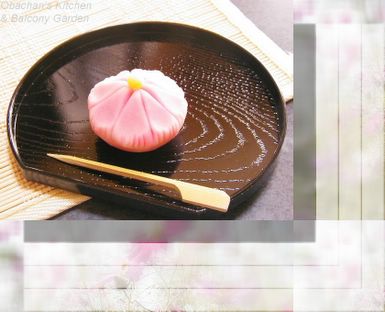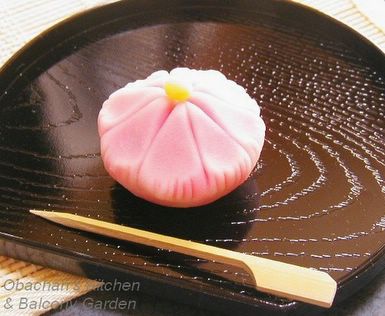
As has been written by many, wagashi (Japanese traditional confectionery) is known for its beauty that reflects the changing seasons in Japan. It does not necessarily mean using ingredients in season like baking blueberry pie in summer. Those traditional sweets are actually shaped and colored to depict various seasonal features.
There is no doubt that tea ceremony played a crucial role in the history of wagashi. In this highly ritualized preparation and drinking of tea, seasonal themes must always be reflected on everything: equipments used for preparing/drinking tea, hanging scroll picture on the wall, flowers in a vase, and wagashi served before drinking tea. To meet this need, Japanese confectioners have been making great efforts to creatively represent seasonal themes with their wagashi.
Starting this month, I’m going to post at least one wagashi entry a month, coupled with photos of what it represents, such as a flower, leaf, fruit or scenery…plus some trivia about Japanese sweets. In twelve months, my work will turn into a lovely sugary calendar with my own wagashi photos ;)
(I take photos of wagashi myself, but I don't make the wagashi myself.)
*****
Read More

Cosmos (Mexican Aster)
This is nerikiri in the shape of an autumn flower, cosmos (Mexican aster). Nerikiri is a type of wagashi made mainly from sweet white bean paste. A mochi -like ingredient called gyuhi (made from shiratamako, sugar and water) or sometimes yam is kneaded into the bean paste to make it softer, smoother and moister. It not only makes the texture of the paste pleasant to the tongue but also makes it easier to handle and suitable for molding. Also the nerikiri paste can be colored easily. In a sense it seems similar to marzipan craft, but while marzipan is often used for decorating cakes, basically nerikiri is not meant to be used for decorating other sweets, as far as I know. The name “nerikiri” probably came from the kneading work. In Japanese neru means “to knead” and kiru “to cut.”
 Very often, nerikiri has sweet bean paste filling inside, thus the sugar content is not very low. However, a good nerikiri never tastes overly sweet for me; the sweetness is not heavy but by no means too light or tasteless, which goes wonderfully well with bitter and flavorful matcha (green tea served in tea ceremony). Very often, nerikiri has sweet bean paste filling inside, thus the sugar content is not very low. However, a good nerikiri never tastes overly sweet for me; the sweetness is not heavy but by no means too light or tasteless, which goes wonderfully well with bitter and flavorful matcha (green tea served in tea ceremony).

* Mochi --- Rice cake.
* Shiratamako --- A type of rice flour. The rice is soaked into water and milled as in water (not drained), pressed to get the water out and dried into solid, then made into powder. A finer flour than mochiko.
*Wagashi from OGASAWARA 3-4-6 Honmachi, Kochi city, Kochi
|
![]()


![]()
21 comments:
Such pretty shots, Obachan. I like the 2nd & last one - looks like a painting. Keep up the good work :)
great post and an excellent idea to have monthly posts on wagashi. There's so much to know about Japanese cuisine. I look forward to reading your posts!
wonderful! keep it coming!!
i love the plate you put the wagashi on!
Oh, I thought the plate was made of chocolate ... what a good idea, yes?
God bless, Christine in Los Angeles
This is one of the reasons I always come back to your site. What a nice idea and how interesting for your readers from other countries. And I agree with Amber your lovely wagashi picture looks like artwork. (Of course, God invented beauty, so why not?)
Abmer Amethryne
Thank you. I found it’s more difficult to take good photos of wagashi than I thought.
Sara
That’s exactly right ;)
Mumu
Thanks. Honestly, I found out how little I knew about Japanese cuisine after I started blogging. It’s a lot of researching and re-discovering of my own culture, and it’s eye-opening and so much fun to me.
Humour and last laugh
Thank you. Hope you keep coming back and enjoy :)
evangeline
It’s from the famous 100-yen shop. Actually it’s a bit too big to put just one wagashi on. ;P
Christine in LA
It’s certainly a tasty idea, but I guess it should be used in winter season only. Otherwise it’s going to be pretty messy.
Annie
Thanks. I really wish I could capture the beauty of wagashi and the nature much better. It’s a big headache that in my photos the colors don’t turn out as they really are. It’s so frustrating… and I guess there’s a lot more for me to learn about lighting, settings of my digital camera, and proper photo re-touch… but I guess I’m having fun :) It’s fun to try, discover and improve something, and by doing all these, I can get closer to the things I’d been just overlooking or taking for granted. I like it. :)
I love your pictures of the beautiful wagashi! They make my mouth water. I'm so addicted to mochi!
hi obachan ,
the wagashi looks really good and ur description is really helpful . As a gaijjin in Japan, who is just beginning to get into japanese cooking, I find it hard to shop for ingredients ( I dont read or write nihongo yet). Could you also include a write up about common kitchen ingredients and how one can identify them . I picked up some pinhao the other day but still looking for recipes :)
I bet you had to be very strong to cut into this beautiful sweet cosmos.
I'd like to make some shiratama-dango but I've never seen shiratama-ko in shops...we can get azuki beans(bizarrely,called ADUKI here in the U.K).I wonder if I can use something else instead.Any suggestions?
Looking forward to your wagashi entries!
I really love the way "Wagashis" look; They really are beautiful and very poetic looking! Unfortunately, I never was lucky enough to taste any...
Amanda
I love mochi, too. :D Oh, that reminds me. I have to try out a butter mochi recipe I saw on someone’s site a while ago…
bilbo
Sure. That will be interesting to me, too. Common kitchen ingredients means seasonings like miso, soy sauce, mirin etc? BTW, what’s pinhao?
KT121
Well, my mom teaches tea ceremony and I acted as her guest when she practiced at home, so I’ve been trained to be a cold-hearted slaughterer. You know in tea ceremony you need to finish eating wagashi before the tea is served. That’s something I don’t like…I really want to eat wagashi and drink tea alternately, enjoying the contrast, but it’s not allowed. About the sub for shiratamako, if you can find dangoko or mochiko over there, that might work with a bit difference in texture, but I’m not 100% sure. Sorry.
Rosa’s Yummy Yums
Oh I hope you have a chance to taste one someday : )
That's so beautiful. I look forward to seeing more.
Sidherian
Thanks obachan.
I'll carry on my research!
Sidherian
Thanks. I’m so excited about this project. There’ll be another beautiful entry next month. ;)
KT121
Good luck!
ooops obachan,
maybe I misspelt that. I read abt it in a recipe book I bought recently. Have packed the book away as I am moving. So , cant verify. Its a pinkish red looking thing 2-3 inches in length and has layers like an onion. its not round though. more like a thin bulb.
Now I'll try to look it up and let u know what I actually bought.
glutton rabbit
Thanks. There’ll be a great one next month.
bilbo
Mmmm…I’m still not quite sure what it is… Did it look like this?
obachan wa totemo jozu desu!!!
yep it is the myoga. I googled it. some websites say it is the japanese ginger and is often used as a seasoning. How would you use it .
Take care,
bilbo
Thanks, bilbo.
Myoga is often used as a condiment. You can slice it into thin strips and use as a topping for cold somen noodles. Or you can put the slices in miso soup. But to be honest, I don’t really care for those.
I like sweet & sour myoga pickles and myoga tempura! I guess I can post about them sometime soon.
hello obachan. am a big (silent) fan of your site. i LOVE japanese sweets. I'm been able to buy from some select japanese groceries here, but they are pretty pricey.
anyway, a question. what do you call the rice balls (flattish ones) which have a mungbean filling? there is also a variant where the rice flour is flavored with green tea. any chance you may have a recipe? (hoping)
Hi pasion,
Thanks for your comment. Sorry I didn't get back to you sooner, but I couldn't find any information about what you are asking. I have never seen a flatten rice balls with mungbean filling... Do you have a photo or URL to the photo of the rice balls you are talking about?
Post a Comment